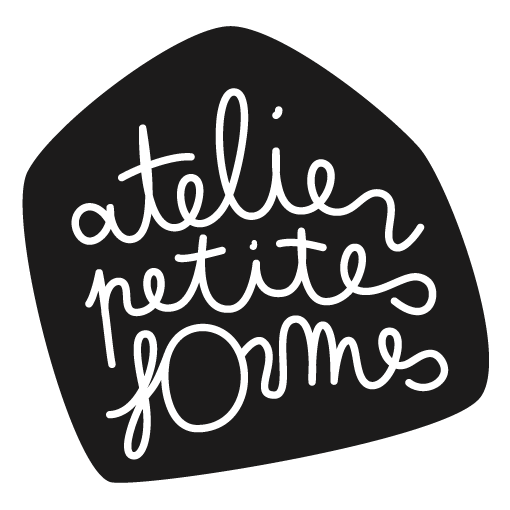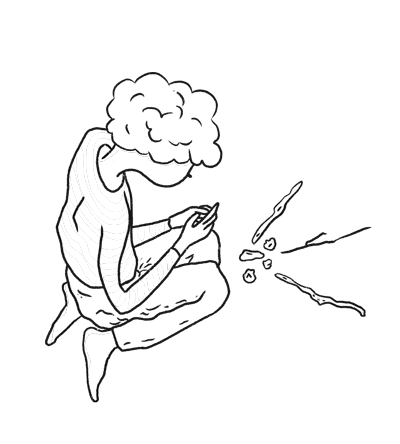Process of creating a felt figure
I would like to share with you my process of creating and making my Atelier Petites Formes wool felt animals.
I am ManonI design and make simple and natural toys with ecological values for your children.
The choice of the animal
According to the seasons, depending on my fantasy or the desire of my little boy or my customers, I choose an animal to make in wool felt. I look at photos, I study the typical features of its anatomy, of its attitude in order to get closer to what characterizes it best. This research allows me to draw the first features of its silhouette, a minimalist silhouette with just the right amount of curves and details to find the animal.
And then I continue to document myself on the animal. Often the animals I make are only a few individuals living in their natural space, making them exist in my hands connects me to them. I remember when I wanted to develop the giraffe Atelier Petites Formes, at the same time there was a terrible drought in Kenya that took many giraffes with it.(1) It was difficult for me to confront this reality. The most important animals in children's imaginations are either hunted, exploited or on the verge of extinction. That frightens me. What about you?
The choice of wool
You may wonder why I use wool to make my toys as I deplore animal exploitation. Firstly, wool is a wonderful material and I am very grateful to the sheep that have allowed this beautiful wool to be in my hands.
I am also against synthetic or mixed materials. They are polluting to manufacture and polluting to recycle (if they are brought to this stage), if they are thrown in the trash they end up like the rest, buried or burned. This is bad for the environment and bad for our babies and children.
A baby manipulates a toy, an object in all directions, he studies the shape in its deformation, he studies the material in its solidity, its resistance. If we offer him healthy and quality materials, his experience will be without risk and he will be able to carry out his studies serenely. If we offer him petrochemical plastics, yes, petroleum, then the fibres that degrade when handled with the hands or in the mouth allow their plastic particles to disperse. Today we know. We know the dangers, the damage to human health and the health of the planet.(2)
I also chose local wools for the stuffing, they come from Ariège, Brittany or Corsica.
The wool felt comes from South America and Southern Europe, countries where mulesing (3) is prohibited by law. The wool is dyed and felted in Holland.
From design to pattern
After this stage of information, of connection to the animal to be shaped, I refine my drawing, I adapt the dimensions to the animals already made and I project in my head the number of pieces that the pattern will require.
Using my supplier's felt colour chart, I select the colours closest to the animal. Often the natural, undyed wool felts, i.e. the pure colours of sheep fleeces (shades from off-white to mottled black, passing through beiges, greys and browns) are the most adapted to give the realism that children need for the construction of the world image.
The dyed felts have high quality colours. They are Oeko-Tex 100 certified, which gives Atelier Petites Formes toys an additional quality to their safety and ecological characteristics.
I draw and cut each piece of the pattern on a cardboard. Then I place them on my felt pen strategically to make as little waste as possible.
A taste for detail
I assemble the pieces together by hand with cotton thread in a colour close to or contrasting with the colour of the wool felt. The cotton thread is Oeko-Tex 100 certified.
The stitch I use for sewing is basically the scallop stitch. It gives a nice finish and is strong. I embroider the eyes and sometimes the muzzle.
I stuff the legs, the head and the neck with flock wool or carded wool that I choose from France (Corsica, Brittany or Ariège).
Finally, I finish the stitching on the animal's back. I add the tail or other hair if there is any. The animals I've made so far have manes and tails made from Oeko Tex 100-certified cotton yarn, but wool yarns may be used in the future. Characteristic details such as tasks or stripesI add small strands of carded wool that I needle-felt onto the body of the felt animal.
Thank you for reading this article to the end. I hope you have been able to obtain all the information that was perhaps previously mysterious.
Do not hesitate to write to me if you would like me to address other questions about my work or more generally about my approach.
Press articles
(1) https://www.francetvinfo.fr/monde/afrique/environnement-africain/video-rechauffement-climatique-on-n-avait-jamais-vu-de-girafes-mourir-a-cause-de-la-secheresse-l-image-qui-a-choque-le-monde_5114950.html
(2) https://www.lemonde.fr/planete/article/2022/02/17/des-polluants-du-quotidien-deleteres-pour-la-construction-du-cerveau-des-jeunes-enfants_6114151_3244.html
(3) https://www.thegoodgoods.fr/mode/le-probleme-du-mulesing-dans-la-laine/
(4) https://www.thegoodgoods.fr/mode/instagram-video-igtv-label-oeko-tex-standard-100/


